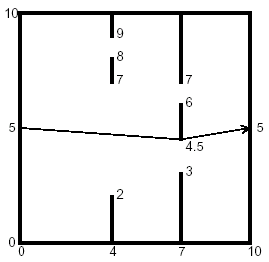poj 1556 The Doors
来源:互联网 发布:数据分析展示平台 编辑:程序博客网 时间:2024/05/29 15:45
The Doors
Time Limit: 1000MS Memory Limit: 10000KTotal Submissions: 6340 Accepted: 2545
Description
You are to find the length of the shortest path through a chamber containing obstructing walls. The chamber will always have sides at x = 0, x = 10, y = 0, and y = 10. The initial and final points of the path are always (0, 5) and (10, 5). There will also be from 0 to 18 vertical walls inside the chamber, each with two doorways. The figure below illustrates such a chamber and also shows the path of minimal length.


Input
The input data for the illustrated chamber would appear as follows.
2
4 2 7 8 9
7 3 4.5 6 7
The first line contains the number of interior walls. Then there is a line for each such wall, containing five real numbers. The first number is the x coordinate of the wall (0 < x < 10), and the remaining four are the y coordinates of the ends of the doorways in that wall. The x coordinates of the walls are in increasing order, and within each line the y coordinates are in increasing order. The input file will contain at least one such set of data. The end of the data comes when the number of walls is -1.
2
4 2 7 8 9
7 3 4.5 6 7
The first line contains the number of interior walls. Then there is a line for each such wall, containing five real numbers. The first number is the x coordinate of the wall (0 < x < 10), and the remaining four are the y coordinates of the ends of the doorways in that wall. The x coordinates of the walls are in increasing order, and within each line the y coordinates are in increasing order. The input file will contain at least one such set of data. The end of the data comes when the number of walls is -1.
Output
The output should contain one line of output for each chamber. The line should contain the minimal path length rounded to two decimal places past the decimal point, and always showing the two decimal places past the decimal point. The line should contain no blanks.
Sample Input
15 4 6 7 824 2 7 8 97 3 4.5 6 7-1
Sample Output
10.0010.06
这道题结合了计算几何和最短路,首先记录所有点,包括(0,5),(10,5)还有每个门的上下两个点。
由于题目已经告知点的输入顺序是x递增,x相同的情况下y递增。那么我们在建图时,只需要前面的点和后面的点连边即可,因为不可能往回走的。在枚举两点(x1,y1),(x2,y2)[注:x1<x2]加边时,我们考虑x1和x2之间是否有点(代表有门)。
如果没点,之间连一条边,权值就是欧几里得距离。
如果有点,我们4个点连着看,分别对应了3堵墙和2个门,我们要判断(x1,y1)和(x2,y2)的连线是否与墙相交,这里用计算几何中的叉积来判断,如果墙的两点在连线的同侧或者墙的1点在连线上,那么表示墙和连线不相交,如果x1和x2之间的所有墙都不与连线相交,则连一条边。
建完图之后,就是裸的最短路了,可以用dijkstra算法,但是这里我为了练习bellman-ford,所以用了这个算法。
代码:
#include<cstdio>#include<iostream>#include<cstring>#include<cmath>#define eps 1e-6#define Maxn 100using namespace std;struct line{ int u,v; double w; line(){} line(int uu,int vv,double ww):u(uu),v(vv),w(ww){}}p[Maxn*Maxn];double x[Maxn],y[Maxn],dist[Maxn];const double inf=100000000;bool cross(int l,int r,double dx,double dy1,double dy2){ double x1=x[r]-x[l],y1=y[r]-y[l]; double x2=dx-x[l],y2=dy1-y[l]; double x3=dx-x[l],y3=dy2-y[l]; double t1=x1*y2-y1*x2,t2=x1*y3-y1*x3; if(abs(t1)<eps||abs(t2)<eps||t1*t2>0) return true; return false;}bool ok(int l,int r){ int i=l; for(;abs(x[i]-x[l])<eps;i++); while(abs(x[i]-x[r])>eps){ if(!(cross(l,r,x[i],0,y[i])&&cross(l,r,x[i],y[i+1],y[i+2]) &&cross(l,r,x[i],y[i+3],10))) return false; i+=4; } return true;}double dis(int i,int j){ return sqrt((x[i]-x[j])*(x[i]-x[j])+(y[i]-y[j])*(y[i]-y[j]));}void bellman(int u,int n,int m){ for(int i=0;i<n;i++) dist[i]=inf; dist[u]=0; bool flag=true; for(int i=1;i<n;i++){ flag=false; for(int j=0;j<m;j++) if(dist[p[j].u]+p[j].w<dist[p[j].v]){ dist[p[j].v]=dist[p[j].u]+p[j].w; flag=true; } }}int main(){ int n; double m; x[0]=0,y[0]=5; while(scanf("%d",&n),n!=-1){ int tot=1; while(n--){ scanf("%lf",&m); for(int i=0;i<4;i++){ scanf("%lf",y+tot); x[tot++]=m; } } x[tot]=10,y[tot++]=5; int num=0; for(int i=0;i<tot;i++) for(int j=i+1;j<tot;j++){ if(abs(x[j]-x[i])>eps&&ok(i,j)) p[num++]=line(i,j,dis(i,j)); } bellman(0,tot,num); printf("%.2f\n",dist[tot-1]); }return 0;} 0 0
- poj 1556 The Doors
- poj 1556 The Doors
- POJ 1556 The Doors
- poj 1556 The Doors
- poj 1556 The Doors
- Poj 1556 The Doors
- POJ 1556 The Doors
- poj 1556 The Doors
- poj 1556 The Doors
- poj 1556 The Doors
- POJ 1556 The Doors
- poj 1556The Doors
- POJ 1556 The Doors
- poj 1556 The Doors
- POJ 1556 The Doors 笔记
- zoj 1721 || poj 1556 The Doors
- POJ 1556 The Doors(Dijkstra+计算几何)
- POJ 1556 The Doors (线段相交+Dijkstra)
- 1024. Palindromic Number (25)
- 有序线性表合并的算法
- Qt Creator的下载、安装及试用
- java基础
- 【C++】函数
- poj 1556 The Doors
- 在Libgdx中修正物理引擎Box2d时间步长
- Cocos2d-x3.2 飞机大战类游戏中实现随机出现敌机的方法
- grunt学习笔记(适用初学者)
- Android 开源框架ViewPageIndicator(标签指示器)结合ViewPager使用
- Struts1和Struts2的区别和对比:
- Spring入门简介
- 1027. Colors in Mars (20)
- 【记录】s5pv210运行裸机程序的方法之在iRAM中运行


